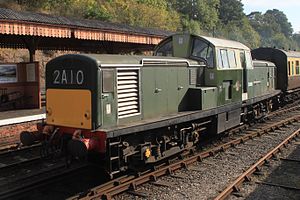British Rail Class 17

D8568 in preservation in October 2015.
|
|||||||||||||||||||||||||||||||||||||||||||||
|
|||||||||||||||||||||||||||||||||||||||||||||
|
|||||||||||||||||||||||||||||||||||||||||||||
|
|||||||||||||||||||||||||||||||||||||||||||||
|
|||||||||||||||||||||||||||||||||||||||||||||
| Type and origin | |
|---|---|
| Power type | Diesel-electric |
| Builder | Clayton Equipment Company & Beyer, Peacock & Co. |
| Build date | 1962–1965 |
| Total produced | 117 |
| Specifications | |
|---|---|
| Configuration: |
|
| • Whyte | Bo-Bo |
| • UIC | Bo'Bo' |
| Gauge | 4 ft 8 1⁄2 in (1,435 mm) standard gauge |
| Wheel diameter | 3 ft 3 1⁄2 in (1.003 m) |
| Minimum curve | 230 feet (3.5 chains; 70 m) |
| Wheelbase | 36 ft 6 in (11.13 m) |
| Length | 50 ft 7 1⁄2 in (15.431 m) |
| Width | 8 ft 9 1⁄2 in (2.680 m) |
| Height | 12 ft 8 in (3.86 m) |
| Loco weight | 68 long tons (69 t; 76 short tons) |
| Fuel capacity | 500 imp gal (2,300 L; 600 US gal) |
| Prime mover |
Paxman 6ZHXL, (2 of) |
| Displacement | Paxman: 2 x 29.4 L (1,790 cu in) = 58.8 L (3,590 cu in) |
| Generator | D8500–D8587: GEC WT800, GEC WT auxiliary D8588–D8616: Crompton Parkinson main and auxiliary |
| Traction motors | GEC WT421, nose-suspended, with single-reduction gear (4 of) |
| Cylinder size | Paxman: 7 in (178 mm) diameter 7 3⁄4 in (197 mm) stroke |
| Transmission | Diesel electric |
| MU working | D8500–D8587 ◆ Red Diamond D8588–D8616 ★ Blue Star |
| Train heating | None; through steam pipe |
| Train brakes | Vacuum |
| Performance figures | |
|---|---|
| Maximum speed | 60 mph (97 km/h) |
| Power output | Engines: 450 hp (336 kW) @ 1500 rpm × 2 |
| Tractive effort |
Maximum: 40,000 lbf (178 kN) Continuous: 18,000 lbf (80.1 kN) @ 13 mph (21 km/h) |
| Brakeforce | 35 long tons-force (350 kN) |
| Career | |
|---|---|
| Operators | British Railways |
| Numbers | D8500–D8616 |
| Axle load class | Route availability 4 |
| Retired | 1968–1971 |
| Disposition | One preserved, remainder scrapped. |
Paxman 6ZHXL, (2 of)
The British Rail Class 17 (also known as the Clayton Type 1) was a class of 117 Bo-Bo diesel-electric locomotives built 1962–1965 by Clayton Equipment Company and their sub-contractor Beyer, Peacock & Co., for British Railways (BR).
Following problems with the single-cabbed pilot scheme Type 1 locomotives, the Class 17s were designed with a centre cab and low bonnets to maximise visibility for the driver. The low engine covers required the use of two Paxman 6ZHXL six-cylinder horizontal engines and these gave unreliable performance even after extensive modifications. The class proved to be one of the least successful of the Type 1s. Withdrawals took place from the late 1960s to 1971, some locomotives having a working life of less than five years. Several were sold to industrial users, but only one has been preserved.
The Type 1 was the lowest power classification for BR mainline diesels. Under BR's 'pilot scheme', three different designs of Type 1 locomotive had been produced. Two of these (Classes 15 and 16 under the TOPS classification system) were of a 'road-switcher' type layout based on the 10800 prototype, with a single off-centre cab, from which forward visibility for the crew was poor in both directions of travel, while the third (Class 20) had its cab at one end, giving good visibility in that direction only. After experience with these, and although Class 20 was a technical success, BR decided that it wanted a single-cab Type 1 locomotive with good forward visibility in both directions.
The result was the Class 17, fitted with a centre cab and low engine covers. These requirements meant that instead of having a single large engine, it was necessary to use two smaller six-cylinder horizontal engines, one on either side of the cab.
...
Wikipedia
